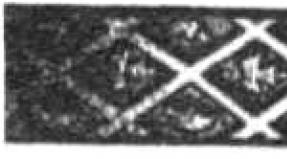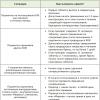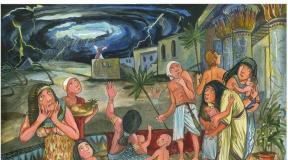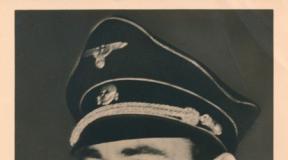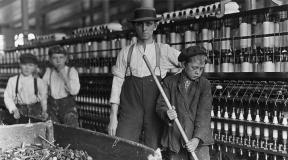The history of the Easter holiday. Telling children about Easter - the history of the holiday The first mention of Easter
In 2019, Easter - the most important Christian holiday - is celebrated on April 28. 48 days are being prepared for the Bright Sunday of Christ: 40 days last and Passion Week goes on for eight days. Despite the importance of the holiday in the Christian world, it appeared long before the death and resurrection of Jesus. The editors of the site explain where the Jewish Pesach came from, how it is connected with the Christian Easter, and also why we paint eggs and bake Easter cakes on Easter
Photo: Virgin and newborn Jesus Christ / tbn-tv.com
The origin of the holiday
The holy holiday of Easter appeared even before the birth of Jesus Christ. It was celebrated in honor of the liberation of the Jewish people from Egyptian slavery. According to biblical tradition, the Jews were forcibly kept in Egypt for 430 years, until they were rescued by the prophet and founder of Judaism, Moses.
One day God appeared to Moses in the form of a blazing but unburned bush. The Lord told the shepherd to come to the Egyptian lands and convince the pharaoh to let the Jews go. At the age of 80, the prophet appeared before the ruler of Egypt, but no matter how he tried to reason with the pharaoh, the Israelites remained in slavery. As punishment, the Lord sent ten plagues on Egypt: punishment by blood, an invasion of frogs, an invasion of blood-sucking insects, punishment by dog flies, pestilence of cattle, ulcers and boils, thunder and fiery hail, an invasion of locusts, Egyptian darkness, and, finally, the death of the firstborn.
 Photo: fiery lightning over the sky of Egypt / illustrators.ru
Photo: fiery lightning over the sky of Egypt / illustrators.ru Neither frogs, nor bloody rivers, nor fiery hail did not frighten the pharaoh. Only the death of his own child forced the ruler to release the Jews. The terrible punishment did not affect everyone: Moses warned the Israelis that the doors of the houses should be marked with the blood of a one-year-old immaculate lamb, and the animal itself should be baked and eaten with the family. The Jewish houses that carried out the order of Moses were not touched by death.
When the Israelites approached the Red Sea, the water opened up and the Jews walked along the bottom.
After these events, the Pesach holiday appeared, aka Easter, which literally translates from Hebrew as “passed by, passed by.” This is a direct reference to the passage of the Jews past the water along the bottom of the Red Sea.
Connection with Christian Easter
Christian Easter is inextricably linked with the life, death and resurrection of the son of God Jesus. Christ was born in the small village of Nazareth, near Bethlehem. When he was 30 years old, he received from John the Baptist. Three years later, Jesus gathered 12 of his closest disciples at the Easter feast, to whom he said that soon one of them would betray him, thereby predicting the betrayal of Judas.
 Photo: Procession of Jesus Christ to Mount Golgotha / catholic.tomsk.ru
Photo: Procession of Jesus Christ to Mount Golgotha / catholic.tomsk.ru The day after the Last Supper, Pontius Pilate, the Roman prefect of Judea, ordered that Christ be arrested, tortured, and executed by crucifixion. The priests envied the Son of God, because crowds of believers followed him, and the authorities wanted to eradicate Christianity in the bud. After being beaten with whips and “crowned” with a crown of thorns, the exhausted Jesus put the cross on his back and carried it to the top of Mount Calvary. Jesus' way of the cross through old Jerusalem and the serpentine of the mountain became one of the prototypes of the Christian procession.
The death of the son of God on Mount Golgotha is a kind of allegory for the murders of sacrificial lambs. Just as the Jews sacrificed one-year-old immaculate lambs, so Jesus gave his life for the remission of sins and the purification of human souls. Christ died after the Jewish Passover, on Friday, which was called Holy.
Why do we paint eggs for Easter?
On the third day after the burial of Christ, on Sunday, Mary Magdalene, one of the followers of Jesus, together with the myrrh-bearing women, went to his tomb to leave incense. Approaching the cave, she saw that the stone had been moved away, and the Angel of the Lord in a snow-white robe was sitting in the cave. The angel told Mary that Jesus was not in the tomb - he had risen. At that moment, the Son of God himself appeared before her. Overjoyed, Mary hurried to tell the good news to the emperor Tiberius himself. Entrance to the great Roman pontiff without a gift was forbidden, so Mary took it. Hearing about the resurrection of Christ, Tiberius laughed and said that he would believe in it only when the egg in Mary's hands turns red. In the same second, the eggshell turned purple, as a symbol of the shed blood of Christ.
 Photo: Mary Magdalene presents Tiberius with a purple egg / zolushka-new.com
Photo: Mary Magdalene presents Tiberius with a purple egg / zolushka-new.com However, the spiritual writer and bishop of the Russian Orthodox Church Dmitry Rostovsky believed that Mary Magdalene gave the emperor an egg already painted red. This gift aroused the curiosity of the emperor, and she told him about Jesus Christ, after which he believed. In Orthodoxy, this legend, apparently, penetrated under the influence of Catholicism.
According to another version, the Mother of God, the mother of Jesus, entertained Christ with painted eggs when he was a baby.
Why do we bake a holiday cake
Festive Easter cake is a kind of church artos - yeast bread with the image of Christ. After the Ascension of Christ, the apostles left a piece of bread for the son of God at the meal, thereby depicting his presence at the dinner table. Catholics bake festive bread from shortcrust pastry and call it "baba".
 Photo: Orthodox family praying at the table with holiday cakes / babiki.ru
Photo: Orthodox family praying at the table with holiday cakes / babiki.ru The word "Kulich" comes from the Greek kollikion, which means "round bread". This word is found not only in Russian. The Spaniards call the "home" artos kulich, and the French call it koulitch.
Easter of Christ. How many days are celebrated?Easter- the most important and solemn Christian holiday. It takes place every year at a different time and refers to mobile holidays. Other movable holidays also depend on the day of Easter, such as:, (Pentecost) and others. The celebration of Easter is the longest: for 40 days, believers greet each other with the words " Christ is Risen!» - « Truly Risen! The Day of the Bright Resurrection of Christ for Christians is a time of special celebration and spiritual joy, when believers gather for services to glorify the risen Christ, and the whole Easter week is celebrated " like one day". The church service throughout the week almost completely repeats the nightly Easter service.
The Passover Event: An Excerpt from the Gospel
christian holiday of easter- this is a solemn remembrance of the Resurrection of the Lord on the third day after His suffering and death. The very moment of the Resurrection is not described in the Gospel, because no one saw how it happened. The descent from the Cross and the burial of the Lord took place on Friday evening. Since Saturday was a day of rest for the Jews, the women who accompanied the Lord and the disciples from Galilee, who were witnesses of His suffering and death, came to the Holy Sepulcher only a day later, at the dawn of that day, which we now call Sunday. They carried incense, which, according to the custom of that time, was poured over the body of a dead person.
After the Sabbath, at dawn on the first day of the week, Mary Magdalene and another Mary came to see the tomb. And behold, there was a great earthquake, for the Angel of the Lord, who descended from heaven, approached, rolled away the stone from the door of the tomb and sat on it; his appearance was like lightning, and his clothes were white as snow; fearful of him, the guards trembled and became like dead men; The angel, turning his speech to the women, said: do not be afraid, for I know that you are looking for Jesus crucified; He is not here - He is risen, as he said. Come, see the place where the Lord lay, and go quickly, tell His disciples that He has risen from the dead and is ahead of you in Galilee; you will see him there. Here, I told you.
And coming out of the tomb hastily, they ran with fear and great joy to tell His disciples. When they went to tell His disciples, and behold Jesus met them and said: Rejoice! And they, coming forward, took hold of His feet and worshiped Him. Then Jesus said to them: Do not be afraid; go tell my brethren to go to Galilee, and there they will see me” (Matthew 28:1-10).
Russian Faith Library
→
Easter celebration in history. Why is Sunday called Sunday?
From the Christian holiday of Easter comes the modern name of the day of the week - Sunday. Every Sunday of the week throughout the year, Christians especially celebrate with prayer and a solemn service in the temple. Sunday is also called little Easter". Sunday is called Sunday in honor of the resurrected on the third day after the crucifixion of Jesus Christ. And although Christians remember the Resurrection of the Lord weekly, this event is especially solemnly celebrated once a year - on the feast of Easter.
In the first centuries of Christianity there was a division into easter godmother And Sunday Easter. Mentions of this are contained in the works of the early Church Fathers: the epistle of St. Irenaeus of Lyons(c. 130–202) to the bishop of Rome Victor, « A word about Easter» saint Meliton of Sardis(early II century - c. 190), the works of the saint Clement of Alexandria(c. 150 - c. 215) and Pope Hippolytus (c. 170 - c. 235). Easter godmother- the memory of the suffering and death of the Savior was celebrated with a special fast and coincided with the Jewish Passover in memory of the fact that the Lord was crucified during this Old Testament holiday. The first Christians prayed and strictly fasted until Easter Sunday - a joyful remembrance of the Resurrection of Christ.
At present, there is no division into Easter of the Cross and Sunday, although the content has been preserved in the liturgical Rule: the strict and mournful services of the Great Thursday, Friday and Saturday end with a joyful and jubilant Easter service. Actually, the Easter night service itself begins with a mournful midnight office, on which the canon of Great Saturday is read. At this time, in the middle of the temple there is still a lectern with a Shroud - an embroidered or painted icon depicting the position of the Lord in the tomb.
What is the date of Easter for the Orthodox?
The early Christian communities celebrated Easter at different times. Some together with the Jews, as Blessed Jerome writes, others - the first Sunday after the Jews since Christ was crucified on the day Passover and rose again the morning after the Sabbath. Gradually, the difference in the Easter traditions of the local Churches became more and more noticeable, the so-called " easter dispute» between the Eastern and Western Christian communities, there was a threat to the unity of the Church. On, called by the emperor Constantine in 325 in Nicaea, the question of a single celebration of Easter for all was considered. According to church historian Eusebius of Caesarea, all the bishops not only accepted the Creed, but also agreed to celebrate Easter for everyone on the same day:
For the consonant confession of the Faith, the saving celebration of Pascha had to be celebrated by everyone at the same time. Therefore, a general resolution was made and approved by the signature of each of those present. Having finished these things, the basileus (Constantine the Great) said that he had now won a second victory over the enemy of the Church, and therefore made a victorious feast dedicated to God.
Since that time, all local Churches began to celebrate Easter the first Sunday after the first full moon following the vernal equinox. If Jewish Easter falls on this Sunday, then Christians postpone the celebration to the next Sunday, because even in, according to the 7th rule, Christians are forbidden to celebrate Easter with Jews.
How to calculate the date of Easter?
To calculate Easter, you need to know not only the solar (equinox), but also the lunar calendar (full moon). Since the best experts on the lunar and solar calendar lived at that time in Egypt, the honor of calculating the Orthodox Paschalia was given Bishop of Alexandria. He was to inform all the local Churches annually about the day of Pascha. Over time it was created Paschalia for 532 years. It is based on the periodicity of the Julian calendar, in which the calendar indicators for calculating Easter - the circle of the Sun (28 years) and the circle of the Moon (19 years) - repeat after 532 years. This period is called great indiction". The beginning of the first "great indiction" coincides with the beginning of the era " from the creation of the world". The current, 15th great indiction, began in 1941. In Russia, Easter tables were included in the liturgical books, for example, the Followed Psalter. Several manuscripts of the 17th-17th centuries are also known. entitled " Great Peace Circle". They contain not only Paschalia for 532 years, but also tables for calculating the date of Easter by hand, the so-called Five-Fingered Paschalia or " hand of Damascus».
It is worth noting that in the Old Believers, knowledge has been preserved to this day, how to calculate the date of easter by hand, any mobile holiday, the ability to determine what day of the week a particular holiday falls on, the duration of Peter's fast and other important information necessary for the celebration of worship.
Orthodox Easter service
Throughout the Holy Week preceding Easter, each of which is called Great, Orthodox Christians celebrate the Passion of Christ, the last days of the Savior's earthly life, His suffering, crucifixion, death on the Cross, burial, descent into hell and Resurrection. For Christians, this is a particularly revered week, a time of especially strict fasting, preparation for the meeting of the main Christian holiday.
Before the start of the festive service, the Acts of the Apostles are read in the temple. Easter service, as in ancient times, takes place at night. The service begins two hours before midnight with Sunday Midnight Office, during which the canon of Great Saturday is read. sea wave". On the 9th ode of the canon, when the irmos is sung " Don't cry for me, Mother”, after incense, the Shroud is taken to the altar. Among the Old Believers-bezpriests, after the third song of the canon and the saddle, the word is read Epiphanius of Cyprus « What is the silence».
After the Midnight Office, preparations for the procession begin. The clergy in brilliant robes, with a cross, the Gospel and icons, leave the temple, followed by those praying with burning candles; three times they go around the temple salting (according to the sun, clockwise) with the singing of stichera: “ Your Resurrection, Christ the Savior, the angels sing in heaven, and grant us on earth with pure hearts to glorify you". This procession is reminiscent of the procession of myrrh-bearing women to the tomb in the deep morning to anoint the Body of Jesus Christ. The procession stops at the western doors, which are sometimes closed: this again reminds of the myrrh-bearing women who received the first news of the resurrection of the Lord at the door of the tomb. “Who will roll away the stone from the tomb for us?” they wonder.
 Procession for Easter at the Old Believers
Procession for Easter at the Old Believers The priest, after shaking the icons and those present, begins the bright matins with the exclamation: "Glory to the Saints, and to the Consubstantial, and Life-Giving, and Inseparable Trinity." The temple is illuminated by many lamps. Priests and clergymen sing three times troparion holiday:
X rt0s resurrected and 3 dead death come to death 2 and 3 grave life gifts.
After this, the chanters repeatedly repeat the troparion when the priest proclaims the verses: “Let God rise again” and others. Then the clergyman with a cross in his hands, depicting an angel who rolled away a stone from the doors of the tomb, opens the closed doors of the temple and all the believers enter the temple. Further, after the great litany, the Paschal canon is sung in a solemn and jubilant chant: Sunday day”, compiled St. John of Damascus. The troparions of the Paschal canon are not read, but are sung with the refrain: "Christ is risen from the dead." During the singing of the canon, the priest, holding the cross in his hands, incenses the holy icons and the people at each song, greeting them with a joyful exclamation: “ Christ is Risen". The people answer: Truly Risen". The repeated exit of the priest with censing and greeting "Christ is Risen" depicts the repeated appearances of the Lord to his disciples and their joy at the sight of Him. After each song of the canon, a small litany is pronounced. At the end of the canon, the following morning light is sung:
P0tіyu ўsnyv ћkw is dead, tsri and 3 gd, three days is wax, and 3 dama raises 1g and 3z8 aphids2, and 3 celebrates death. Easter imperishable, world salvation.
(Translation: King and Lord! Asleep in the flesh like a dead man, You rose three days old, raising Adam from the death and destroying death; You are the Easter of immortality, the salvation of the world).
Then laudatory psalms are read and stichera are sung in praise. They are joined by Easter hymns with the refrain: "May God rise again and scatter against Him." After that, while singing the troparion "Christ is risen", the believers give each other a fraternal kiss, i.e. “They are Christed”, with a joyful greeting: “Christ is Risen” - “Truly Risen”. After singing the Easter stichera, there is a reading of the words of St. John Chrysostom: Whoever is pious and God-loving". Then the litanies are pronounced and the dismissal of Matins follows, which the priest performs with a cross in his hand, proclaiming: "Christ is risen." Next, the Easter Hours are sung, which consist of Easter hymns. At the end of the Easter hours, the Easter Liturgy is performed. Instead of the Trisagion, at the Paschal liturgy, “They are baptized into Christ, put on Christ. Alleluia." The apostle is read from the Acts of St. apostles (Acts 1, 1-8), the Gospel is read from John (1, 1-17), which speaks of the incarnation of the Son of God, Jesus Christ, called in the Gospel "the Word". In some parishes of Old Believers-priests there is an interesting custom - at the Easter Liturgy, the Gospel is read simultaneously by several clergy and even in several languages (repeating each verse of the Gospel several times). So, in some Lipovan parishes they read in Church Slavonic and Romanian, in Russia - in Church Slavonic and Greek. Some parishioners recall that Vladyka (Lakomkin) read the Gospel in Greek on Easter.
A distinctive feature of the Easter service: it is all sung. Temples at this time are brightly lit with candles, which the worshipers hold in their hands and place in front of the icons. Blessing after the liturgy "brashen", i.e. cheese, meat and eggs, is given to believers permission from fasting.
In the evening, Easter Vespers are served. Its feature is the following. The rector puts on all the sacred clothes and after the evening entrance with the Gospel reads on the throne the Gospel, which tells about the appearance of the Lord Jesus Christ to the Apostles in the evening on the day of His resurrection from the dead (John XX, 19-23). Divine service on the first day of St. Pascha is repeated throughout the entire Paschal week, with the exception of the Gospel reading at Vespers. For 40 days, before the feast, Paschal troparia, stichera and canons are sung during the service. Prayer to the Holy Spirit: "To the King of Heaven" is not read or sung until the feast.
Kontakion for the holiday:
More and 3 in the coffin of deathless death, but destroying the power of the year, and 3 resurrected ћkw victor xrte b9e. proclaiming joy to the wives of the mrwn0sits, and 3 their 1m ёpclwm world gifts, and 4 the fallen ones were given resurrection.
(Translation: Although You, Immortal, descended into the tomb, but destroyed the power of hell and, as the Conqueror, resurrected, Christ God, saying to the myrrh-bearing women: "Rejoice." You gave peace to your apostles, you give resurrection to the fallen).
In the incoming and outgoing bows, instead of "Worthy to eat"(up to the giving of Easter) the irmos of the ninth song of the Easter canon is read:
With veti1сz sveti1сz n0vyi їєrli1me, thank God gDнz is on you. lyky nn7e i3 fun1сz сіНne, the same chctaz beautifulz btsde, њ vostanіi rzhctva yoursw2 (bow to the earth).
(Translation: Light up, light up (with joy) the new Jerusalem; for the glory of the Lord has shone upon you; rejoice now and rejoice Zion: and you, Mother of God, rejoice in the resurrection of your Begotten).
Unfortunately, today not every person can get into the Old Believer church for the Easter service. In many regions there are no Old Believer churches, in others they are so remote that it is extremely difficult to get to them. Therefore, the section contains the following of the Paschal Divine Liturgy according to the two Rules. According to the abbreviated Rule, the Paschal Divine Liturgy includes in succession Bright Matins, the Canon of Pascha, the Paschal Hours, and the Luncheon (in civil type). We also offer a detailed follow-up of the service on Holy Easter by the lay order (in Church Slavonic in pdf format), which is widely used in non-priest communities due to the lack of a priesthood.
Russian Faith Library
→
Traditions of celebrating Easter among the Old Believers
The Old Believers of all accords - both priests and bezpopovtsy - have largely common traditions for celebrating the Holy Resurrection of Christ. The Old Believers start breaking the fast for Holy Easter at a meal with their family after the church service. In many communities there is also a common church meal, at which many believers gather. On the day of the Resurrection of Christ, special dishes are put on the table that are prepared only once a year: Easter cake, curd Easter, colored eggs. In addition to special Easter dishes, many traditional Russian delicacies are prepared. At the beginning of the Easter meal, it is customary to eat the food consecrated in the temple, then all the other dishes.
 Easter holiday dishes that are prepared once a year
Easter holiday dishes that are prepared once a year On Easter, it is customary to celebrate Christ - to congratulate each other on the great holiday and exchange colored eggs, as a symbol of life, kissing each other three times. You can read more about Easter kissing in Fr. Ivan Kurbatsky ""

painted in red onion skins, an egg used to be called krashenka, painted - pysanka, and wooden Easter eggs - eggs. The red egg marks for people the rebirth by the blood of Christ.

The other colors and patterns used to decorate the eggs are an innovation that in many priestless communities not welcome, as well as thermal stickers with the image of the face of Christ, the Virgin, images of temples and inscriptions. All this “printing” is usually widely presented on store shelves in the pre-Easter weeks, but few people think about the future fate of such a thermal sticker - after it is peeled off the Easter egg, it, along with the image of Jesus Christ or the Virgin goes straight to the trash can.

There are a number of differences in the celebration of Easter within the non-priestly agreements. So, in some non-priest communities of Siberia, Easter cakes are not baked at all and, accordingly, they are not consecrated, considering this a Jewish custom. In other communities, there is no changing of clothes, changing of dark clothes and scarves to light ones, parishioners remain in the same Christian clothes that they came to worship. Common in the Easter traditions of the Old Believers of all accords is, of course, the attitude to work during Bright Week. On the eve of a holiday or Sunday, Christians work only until half of the day preceding the holiday, and it is a great sin for the Old Believers to work throughout the Easter week. This is a time of spiritual joy, a time of solemn prayer and glorification of the risen Christ. Unlike the Old Believers-priests, in some priestless concords there is no custom for the mentor to go around the houses of the parishioners with Christ glorification, however, each parishioner, if desired, can certainly invite a mentor to sing Easter stichera and a festive meal.
Happy Easter holiday- the most favorite holiday since childhood, it is always joyful, especially warm and solemn! It brings especially much joy to children, and every believer tries to serve an Easter egg, Easter cake or sweets, especially to a child.
 Egg rolling - old Russian Easter fun for kids
Egg rolling - old Russian Easter fun for kids On Bright Week, in some communities without priests, the ancient fun for kids is still preserved, to which adults also join with undisguised joy - rolling painted (unsanctified) eggs. The essence of the game is as follows: each player rolls his egg along a special wooden path - a chute, and if the rolled egg hits someone else's egg, then the player takes it for himself as a prize. Souvenir gifts are usually laid out not far from the gutter. In the old days, such competitions could last for several hours! And the “lucky ones” returned home with a rich “harvest” of eggs.
 Rolling eggs for Easter at the Moscow Old Believer Prayer Room (DPTSL)
Rolling eggs for Easter at the Moscow Old Believer Prayer Room (DPTSL) For all Old Believers, regardless of consent, Easter is Feast of Feasts and Celebration of Feasts, this is the victory of good over evil, light over darkness, this is a great triumph, an eternal holiday of angels and archangels, immortal life for the whole world, imperishable heavenly bliss for people. The atoning sacrifice of the Lord God and our Savior Jesus Christ, the blood shed by Him on the Holy Cross delivered man from the terrible power of sin and death. Yes it will" Easter is new holy, Easter is mysterious”, glorified in festive hymns, continue in our hearts all the days of our lives!
Russian Faith Library
→
Resurrection of Christ. Icons
In the Old Believer iconography there is no separate icon of the Resurrection of Christ, because the moment of the resurrection of Jesus was not seen not only by people, but even by angels. This emphasizes the incomprehensibility of the mystery of Christ. The image of Christ familiar to us, in snow-white robes, coming out of the coffin with a banner in his hand, is a later Catholic version, which appeared in the churches of the Russian Orthodox Church only in post-Petrine times.
In Orthodox iconography, the icon of the Resurrection of Christ, as a rule, depicts the moment of the Savior's descent into hell and the removal of the souls of the Old Testament righteous from hell. Also, sometimes the resurrected Christ is depicted in radiance, an angel preaching the gospel to the Myrrh-bearing Women, and other subjects related to the Resurrection. The plot "The Resurrection of Christ - Descent into Hell" is one of the most common iconographic plots.
 Resurrection of Christ - Descent into hell. Russia, 19th century
Resurrection of Christ - Descent into hell. Russia, 19th century The general idea of the Easter image of Christ in hell is consonant with the theme of the Exodus of the people of Israel from Egypt. As Moses once freed the Jews from slavery, so Christ goes to the underworld and frees the souls languishing there. And not only liberates, but transfers them to the realm of Truth and Light.

 Descent into hell. Andrei Rublev, 1408-1410
Descent into hell. Andrei Rublev, 1408-1410  Dionysius. Icon "Descent into Hell" (end of the 15th century, Russian Museum).
Dionysius. Icon "Descent into Hell" (end of the 15th century, Russian Museum). 

 Resurrection and descent into hell with Passion and feasts. XIX century. Museum of the History of Religion, St. Petersburg
Resurrection and descent into hell with Passion and feasts. XIX century. Museum of the History of Religion, St. Petersburg
Churches of the Resurrection of Christ
most famous Church of the Resurrection of Christ is an Church of the Holy Sepulcher(Jerusalem Church of the Resurrection of Christ).

Churches of the Resurrection of Christ in Russia were built in the name of the Resurrection of the Word, or Renewal, that is, consecration after the restoration of the Church of the Holy Sepulcher, completed in 355 under St. Equal-to-the-Apostles Constantine the Great.
Several temples in honor of this holiday have been preserved in Moscow, one of them is Church of the Resurrection of the Word on the Assumption Vrazhek. The first mention of the temple dates back to 1548. It was a wooden church that burned down in a great Moscow fire on April 10, 1629. In its place, by 1634, an existing stone temple was built. For almost two centuries the temple stood unchanged, in 1816-1820 the refectory and the bell tower were rebuilt.

One of the oldest churches in Kolomna was consecrated in honor of the Resurrection of the Word. On January 18, 1366, the holy noble prince Dmitry Donskoy and the holy princess Evdokia (monastic Euphrosyne) of Moscow were married in this church. The temple was rebuilt several times. In the 1990s it was returned to the parish of the Assumption Cathedral of the Russian Orthodox Church.

During the time of the Golden Horde in Kolomenskoye Posad was erected, mentioned in the cadastral books of 1577-1578. At the beginning of the 18th century, a temple was built in its place with a main altar in honor of the Resurrection of the Word and an altar church in the name of St. Nicholas. In the early 1990s, this one of the oldest and most beautiful churches in the city of Kolomna, the administration handed over to the community of the Russian Orthodox Old Believer Church. The main temple holiday is now celebrated on December 19, in honor of St. Nikola "winter", and among the people this temple is still known by many as the temple of the Resurrection of Christ.

Old Believer Churches of the Resurrection of Christ
The famous Rogozhskaya bell tower was consecrated on August 18, 1913 in the name of the Resurrection of Christ, after this temple was erected at the expense of philanthropists in honor of granting freedom of religion to the Old Believers. After the temple was defiled during the persecution of the atheists, it had to be re-consecrated. In 1949, it was consecrated in the name of the Assumption of the Most Holy Theotokos, since the old antimis in the name of the Resurrection of Christ disappeared, however, the antimis, consecrated in the name of the Assumption of the Mother of God, was kept at Rogozhsky. The temple remained in this position until January 31, 2014. In the late 1990s, proposals began to be studied to return the temple to its historical name. After the reconstruction and overhaul of the temple in 2012, it had to be re-consecrated. The initiative to reconsecrate the temple with its historical name was supported by the Primate of the Russian Orthodox Old Believer Church, Metropolitan Kornily (Titov) at the Consecrated Cathedral in 2014. February 1, 2015 in the Rogozhskaya Sloboda, the temple-bell tower of the Rogozhsky cemetery was held. Thus he had a historical name.

The Old Orthodox Pomeranian Church belongs to the current one (Moscow). This is the first Old Believer church of the Pomor community (the 2nd Moscow community of Pomor marriage consent), built after the 1905 manifesto on religious tolerance in Moscow. The history of this temple is very long-suffering. Now the restoration of the temple is being continued at the expense of the community members, while services are being held.

Also in Lithuania, in the city of Visaginas, there is the Church of the Resurrection of Christ of the Old Orthodox Pomeranian Church.
Christian Passover and Pesach among the Jews (Jewish Passover)
In 2017, the Orthodox celebrate Easter on April 16, and the Jewish holiday Pesach (Jewish Passover) falls on April 11-17 this year. Thus, many attentive Christians ask the question: Why in 2017 the Orthodox celebrate Easter with the Jews? Such a question comes from the 7th canon of the holy apostles, which literally sounds like this:
If anyone, a bishop, or a presbyter, or a deacon, celebrates the holy day of Pascha before the spring equinox with the Jews: let him be deposed from the sacred order.
It turns out that allegedly this year all Orthodox will violate the 7th Apostolic Canon? In the minds of some Christians, a whole " ecumenical tangle”, when in 2017 Orthodox, Catholics and Jews celebrate Easter on the same day. How to be?
To resolve this issue, you should know that disputes about calculating the day of Easter in the Orthodox Church, in fact, ended with the approval of the Orthodox Paschalia for First Ecumenical Council. Easter tables allow you to calculate the day of Easter calendar, that is, without looking at the sky, but with the help of calendar tables, cyclically repeating every 532 years. These tables have been compiled in such a way that Easter Satisfied Two Apostolic Rules About Easter:
- Celebrate Easter after the first spring full moon (that is, after the first full moon after the spring equinox);
- do not celebrate the Passover with the Jews.
Since these two rules do not unambiguously determine the day of Easter, two more auxiliary rules were added to them, which, together with the apostolic (main) rules, made it possible to determine Easter unambiguously and compile the calendar tables of Orthodox Paschalia. Auxiliary rules are not as important as the apostolic ones, and besides, one of them began to be violated over time, since the calendar method for calculating the first spring full moon, laid down in Paschalia, gave a small error - 1 day in 300 years. This was noticed and discussed in detail, for example, in the Collection of Patristic Canons Matthew Blastar. However, since this error did not affect the observance of the apostolic rules, but only strengthened them, shifting the day of the celebration of Easter a little forward according to the dates of the calendar, the Orthodox Church decided not to change Paschalia, approved by the fathers of the Ecumenical Council. In the Catholic Church, Paschal was changed in 1582 in such a way that the auxiliary canon, which had lost its force, began to be fulfilled again, but the apostolic canon of not co-celebrating with the Jews began to be violated. As a result, Orthodox and Catholic Easter diverged in time, although sometimes they can coincide.
If you look at the two apostolic canons cited above, it is striking that one of them - about not co-celebrating with the Jews - is not quite strictly stated and requires interpretation. The fact is that Passover celebration lasts 7 days. Orthodox Easter, in fact, is also celebrated for 7 days, throughout the entire Bright Week. The question arises: what does do not celebrate with the Jews"? Do not allow the coincidence of Bright Sunday with the first day of the Jewish Passover? Or should we take a more strict approach and not allow the imposition of Bright Sunday on any of the 7 days of the Jewish holiday?
In fact, by carefully studying Paschalia, one might suspect that before the First Ecumenical Council, Christians used both the first (weak) and the second (strong) interpretation of the apostolic canon. However, the fathers of the First Ecumenical Council, when compiling Paschalia, definitely stopped at the first interpretation: Bright Sunday should not coincide only with the first, main day of the Jewish Easter, but it can coincide with the subsequent 6 days of the Jewish holiday. Such was the opinion of the First Ecumenical Council, clearly expressed in Paschalia, which the Orthodox Church still adheres to. Thus, in 2017, the Orthodox do not violate the 7th canon of the holy apostles about celebrating Easter with the Jews, because Christian Easter does not coincide with the first day of Jewish Easter, and on other days such " overlays are not forbidden, especially since there have been similar cases before.
New Paschalists and their teachings
In our time, in 2010, several members of the Russian Orthodox Old Believer Church questioned the patristic interpretation of the apostolic canon on Easter and decided to reconsider this issue. Actually, only one was involved in the revision A. Yu. Ryabtsev and the rest just took his word for it. A.Yu. Ryabtsev, in particular, wrote (we quote his words in part, omitting obvious conjectures):
… Often our Passover coincides with the last days of the Jewish Passover, which is celebrated for seven days, and the first main rule for calculating Passover is violated… In modern practice, we sometimes fall on the last days of the Jewish Passover.
A.Yu. Ryabtsev suggested banning the coincidence of Bright Sunday with all 7 days of the Jewish holiday of Easter and celebrating Orthodox Easter according to new rules he himself proposed. Supporters of this doctrine began to be called " neopaschalists" or " New Easter eggs". On May 1, 2011, they celebrated Easter for the first time under the new rules in an ancient cave temple on Mount Tepe-Kermen in Crimea. After the Council of the Russian Orthodox Church in 2011, which condemned the celebration of Easter according to new calculations, the New Paschalists separated into a separate religious group that still exists today. It includes only a few people. There seems to be some connection between this group and G. Sterligov, who also expressed the idea of changing the day of the celebration of Orthodox Easter.
Easter as the original holiday of the arrival of spring and the awakening of new life. About 3,500 years ago, the Jews gave a new meaning to the canonical holiday of greeting spring - on this day they also began to celebrate the exodus of the Jews from Egypt, described in the Old Testament. About 2 thousand years ago, the Easter holiday acquired another meaning, on this day Jesus Christ was resurrected.
On this day, it is customary to say: “Christ is Risen!”, To which the answer is “Truly Risen!”.
The name Passover comes from the Hebrew word "Pesach", which means "deliverance", "exodus", "mercy".
Easter date
In Christian tradition, Easter is celebrated according to the lunisolar calendar, on the first Sunday after the spring full moon. Easter is always celebrated only on Sunday, but falls on different dates.
Great Lent before Easter
The celebration of Easter in Christianity is preceded by Great Lent - the longest and strictest period of abstinence from many types of food and entertainment.
Easter traditions
It is customary to celebrate the onset of Easter by putting painted Easter cakes on the table and Easter itself - this is the name of the cottage cheese dish in the shape of a pyramid with a truncated top.
In addition, painted boiled eggs are a symbol of the holiday. According to ancient traditions, they were considered a symbol of life. Eggs are also associated with the legend of how Mary Magdalene presented the emperor Tiberius with an egg as a sign that Jesus Christ was resurrected. He said that it was impossible, just as an egg cannot suddenly turn red from white, and the egg turned red in an instant.
Since then, Christian Christians have been painting eggs red for Easter. Although recently, in the masses, eggs are painted in any color or stickers are molded on them.
Although Easter is celebrated by Christians (Catholics and Orthodox) and Jews. The details of the celebration vary.
On Easter, believers often visit churches, illuminate Easter cakes and painted eggs.
Easter holiday history briefly.
The most important holiday in the Orthodox church calendar is the Bright Sunday of Christ, also called Easter. This day is the center of the whole tradition, history and philosophy of Orthodoxy. It symbolizes the victory of life over death in the broadest sense.
The date of the celebration is calculated every year according to the lunar calendar. There are Gregorian and Alexandrian Paschalia - complex astronomical systems for calculating the exact date. The Russian Orthodox Church adheres to the Alexandrian Paschalia and uses the Julian calendar. Sometimes these systems give out one date, then Catholics celebrate Easter together with the Orthodox. In all calendars and traditions, the date of Easter always falls on a Sunday. This day of the week got its name from the holiday.
Holiday name

According to the four Gospels, the Resurrection of Jesus Christ fell on the Jewish holiday of Pesach. On this day, the Jews celebrated the Exodus from Egypt. The Old Testament says that the last "Egyptian plague", which finally persuaded the pharaoh to decide to let the Jews go, was the murder of all the firstborn by an angel. The angel did not touch only those who slaughtered the lamb and smeared their doors with its blood. Thus, the blood of the lamb saved people from death. In the New Testament, Christ is the Lamb who saves people.
Gradually, the Hebrew word "peisach" was transformed into the Russian "Easter". And people began to use the abbreviated name of the holiday more often instead of the full one.
The history of the celebration of Easter

The early Christians believed that they were living in the end of time and every year they expected the Second Coming. In memory of the sacrifice of Jesus, they began to celebrate the liturgy, remembering all the events - from the Last Supper to the Resurrection. Every Friday has become a day of mourning, and Sunday a day of joy. This bitterness and joy reached its climax on the day of the Jewish Passover. Thus was born Easter in our modern sense.
Easter in Russia
The holiday came to our region along with Christianity. After Saint Prince Vladimir baptized Russia, Pascha became the most important state event. Celebrations have since lasted at least three days. Sometimes Russian princes, after successful campaigns or the birth of an heir, stretched out the celebration for a whole week.
Sunday preceded Great Lent, which lasted at least forty days. Our ancestors used this period of time for spiritual purification. The pilgrimage to the monasteries was very popular. Ordinary peasants set out on foot for many kilometers to arrive at the monastery even during fasting. There they confessed and met Pascha already cleansed.
Celebrations in the New Time
At all times, until the end of the first quarter of the 20th century, Easter remained not only the main spring holiday, but also the most central event in the calendar. This was until the early 1920s, when atheism became state policy. The authorities forbade Easter liturgies, opposing the Sunday of Christ with its analogue - Workers' Solidarity Day.
But already in the early nineties of the last century, all the bans were lifted and several red days in the spring appeared again on the calendar. As in the old days, Easter occupies a dominant place among all religious events. Even the head of state on this day attends a service in the Cathedral of Christ the Savior in Moscow.
Folk customs and traditions

Since Christians abstain from fast food for a long time before Easter, many Easter traditions have a culinary character.
Kulich or Paska
The main dish of the holiday is rich Easter cake, which is now commonly called "paska". Easter cakes are baked in advance and the day before the holiday they are lit in the church. Our ancestors called paska a completely different dish - cheese baba. For its preparation, many chicken eggs and selected cottage cheese were used. Easter cakes were baked separately. Pasca had the shape of a pyramid, which symbolized Mount Calvary, where Jesus Christ was buried. Eating Easter symbolized the victory of Christ over death.

It is customary to bring Easter cakes to church in wicker baskets made of wicker or other material. In some parishes, paskas are consecrated on the evening before Easter, in others on Sunday.
A separate tradition is the decoration of baskets. Now many Western attributes have come to us that were previously uncharacteristic of the Orthodox tradition. Such symbols include rabbits, yellow flowers and heart-shaped confectionery.
colored eggs
Together with Easter cakes, it is customary to put eggs in a basket, painted bright red or covered with an intricate pattern. They are also meant to symbolize the victory of life over death. There is a version that this tradition is dictated by the shape of the egg - there is life under the dead shell.
After the Easter meal begins, the children take the eggs in their hands and try to break their friend's egg. This game was called "Christing", because when the egg was hit, the Easter greeting was usually pronounced: "Christ is Risen."
Church Liturgy - Easter Liturgy

Divine services in Orthodox churches begin in the evening of the previous day and continue throughout the night. Although the majority of believers come only in the morning to get to the main part of the action - the Holy Liturgy. In ancient times, it was customary to baptize catechumens on this day. Then, in order to become a Christian, it was necessary to prove one's piety for a long period. Such candidates were called catechumens, they were not allowed to be present in the church during the sacraments.
During Lent, priests wear either passionate red vestments or purple mourning vestments. In such clothes they begin the Easter service. But as soon as the joyful “Christ is Risen” sounds, they change into the most beautiful outfits, sewn from white fabric with an abundance of gold.

Immediately after the end of the festive liturgy, festivities begin. On this day, it is customary to wear the best clothes and not restrain oneself in manifestations of joy. Young guys blow up crackers and fireworks, large fairs open, where not only goods are sold, but various competitions are held. For example, a pole is placed on the main square, to the top of which a valuable item is tied. To win the contest, you need to climb to the top of the pillar and remove this item, receiving it as a prize.

From time immemorial, artisans have used folk festivals to showcase their best products. For example, bakers on this day baked a gigantic Easter cake right on the square and divided it among everyone.
Sunday of Christ was also considered an excellent occasion for charity. On this day, the imperial couple could visit a shelter for orphans or the poor. In the houses of rich people, the poor were received or food was taken out to the street.
In the evening, towards the end of the festivities, it is customary to burn the Easter fire. On the main square of the settlement, a fire of a rather large size was laid out and set on fire after dark. Now, for obvious reasons, this tradition is forgotten. Although in some villages bonfires are lit, but not in the main square, but near the church.
How to tell children about Easter? Offer the children such an interesting story about the holiday with poems.
Today the sun shines brighter
Stronger wind beats in the window,
And the cry rushes to heaven:
"Christ is truly Risen!"
RESURRECTION OF CHRIST
Alyonka and Sasha are very busy today. Mom let them paint pysanky for Easter. Children work hard. There will be sun, trees, and waves on the eggs! And my mother and grandmother are baking Easter cakes in the kitchen. Grandmother promised that while the dough was resting, she would tell the story of this holiday.
Hear you too...
Easter - Holy Resurrection of Christ. This main event in the spiritual life of Christians was called the Feast of Feasts, the king of days. Prepared for it 7 weeks - 49 days. And the week before Easter was called Great, or Passionate. Maundy Thursday is the day of spiritual cleansing, the acceptance of the sacrament of communion. Good Friday is a reminder of the suffering of Jesus Christ, a day of sorrow. Great Saturday is the day of expectation, the Gospel of the Resurrection is already being read in the church. Easter is the Sunday when we celebrate the Resurrection of the Savior.
The Son of God came into this world to save people. He preached Love and the Kingdom of Heaven, created many miracles, healed and resurrected people. Do you remember the Christmas story? Many rejoiced at the appearance of Christ. But there were those who did not believe in his holiness. They tried to stop Jesus from talking about God's Kingdom. Among the leaders of that time there were many who hated Christ and desired to get rid of Him. Judas, one of the disciples of the Lord, decided to hand over Christ to these evil people. He approached his Master and kissed Him. It was a sign. Jesus was immediately taken into custody. And Judas received 30 silver coins for this. Thus, he sold his Master.
Jesus was interrogated before the Sanhedrin, the highest Jewish court. The elders and judges looked for evidence to convict Jesus. They bullied him, but he endured.
In the end, He was sentenced to death. It was a terrible event. Jesus was crucified on the cross on Mount Golgotha. When he died, the earth trembled, the rocks began to disintegrate. It happened on Friday. Now we call this day Good Friday. On this sad day, you need to pray.
When Saturday passed, at night, on the third day after his suffering, the Lord Jesus Christ came to life, rose from the dead. On Sunday morning, women came with incense to anoint the body of the Savior. But instead of Him they saw an Angel. He announced the Resurrection of the Lord: “Do not be afraid. I know that you are looking for the crucified Jesus. But one should not look for the Living among the dead. He is risen as He promised you. Go and tell the disciples of Jesus that He has risen from the dead and is waiting for them.”
.jpg)
Joy swept over the people. Since then we have been celebrating Easter, the holiday of the Resurrection. The Lord conquered death and showed that for those who believe in Him and live according to His commandments, there is neither death nor hell.
Preparing for Easter, people are filled with joy and faith. From Maundy Thursday, a favorite action begins - coloring and painting eggs. A lot of meaning is invested in simple patterns. Wavy lines are seas-oceans. The circle is a bright sun. According to tradition, ready-made krashanki and pysanky were put on fresh sprouted greens of oats, wheat, and sometimes on soft green lettuce leaves, which were specially grown for the holiday. Juicy greenery and bright colors of Easter eggs created a festive mood.
And when mom bakes Easter cakes, the whole house is filled with the sweet aroma of vanilla, raisins - a real holiday!
On the night of the Resurrection of Christ, a festive divine service (Paschal Service of God) takes place. In beautiful baskets, various dishes are brought to the church - Easter cakes, cheese, butter, which symbolize well-being, Easter eggs and krashanka. Salt is placed in the basket - a symbol of wisdom. A solemn procession with a chorister and a priest blesses the people.
After returning home, people break their fast - they eat delicious food after Lent. The rich Easter table is a symbol of heavenly joy and the Lord's Supper. The closest relatives gather for Easter breakfast. The owner approaches the guests with wishes and the words “Christ is risen!”, And then kisses everyone. The answer should be like this: “Truly risen!” The sacred egg is cut into as many pieces as there are people present. A candle burns on the table as a reminder of the lordship of this day. Easter breakfast must start with Easter cake. Even the crumbs of this bread that fell on the floor should never be thrown away.
The holiday lasts all Bright Week. There was a custom in the villages: in the evening, violinists walked around the villages and played under the windows in honor of Christ.
Easter Poems for Children
Verbochki
Boys yes girls
Candles and willows
They carried it home.
The flames are warming
Passers-by are baptized
And it smells like spring.
The wind is distant
Rain, little rain
Don't blow out the fire.
Palm Sunday
I'll be the first to get up tomorrow
For a holy day.
Easter Annunciation
Blows rushed
To blue skies
Silent Valley
Drives away sleep
Somewhere across the road
Read also...
- Maps of the Simbirsk province Old maps of the Simbirsk province by Schubert
- We clean coins at home: with soap, Coca-Cola, citric acid, electrolysis method
- Detailed map of the Oryol region with villages, cities, towns and districts Schubert's map of the Oryol province 1850
- What are the signs advised to do if you find a cross

